An Introduction to your joints
Joints are the connecting points between two bones, they are vital for the skeleton to remain flexible and without them, movement would be quite impossible! There are many examples of joints throughout the body, and each of them have different functions and capabilities, but they’re all incredibly important to your wellbeing.
At Etanics, we understand how important it is to keep things in your body ship-shape - even though it might not seem like a big deal to you now.
What is joint pain?
Joint pain is a very serious problem that can occur in the event of an injury, a nutrient deficiency, or as just a common symptom of aging. Signs of discomfort are typically felt in the knees, hips, spine, or maybe even hands and ankles. The pain can come and go, or be a constant impact on your day to day, with severity ranging from general stiffness to an unpleasant throbbing or burning feeling - not good news! It can limit your ability to perform simple tasks and negatively impact your quality of life. But there are several steps that can be taken, that both help prevent joint pain, or alleviate the symptoms if you are feeling the effects.
Common causes of joint pain
As mentioned before, joint pain can affect anyone, so it’s best to take preventative measures even if you don’t consider yourself at risk. Common causes include:
- Arthritis: There are lots of types of arthritis, but the most common afflictions are Osteoarthritis, where the cartilage that cushions the movement of the joints wears away (typically after the age of 45) and Rheumatoid Arthritis, a chronic disease that cause inflammation and potential deformity within the joints, typically in the fingers
- Tendinitis: This is a condition where the tendons – the connective tissue that connects your bones to your muscles and enables one to move the other – become inflamed. Such cases are typically caused when the tendon is overused repeatedly or overstretched in a single movement
- Previous injuries: Historic injuries, such as sprains, broken bones etc can also cause the joints to become painful, although this is typically limited to the healing period, it is possible for a dull ache to remain long after the incident
Treating joint pain
Treating joint pain is something that should be done by a trained professional in the medical field, this can include guidance on over-the-counter medication, prescription medication or surgery. But there are some lifestyle changes that you can adopt now, that may stand you in good stead against joint pain in the future:
- Regular Exercise – By engaging in low-impact, regular exercise such as swimming, walking and cycling, you can regularly build and strengthen your joints and improve their flexibility, without the risk of excessive strain.
- Hydration – Drinking enough water helps to keep your cartilage hydrated, which in turn supports the natural function of your joints and reduces wear caused by friction.
- Maintaining a Healthy Weight – Excess weight on the body can strain your joints, especially those designed to bare weight such as your hips, knees and ankles. By maintaining a healthy weight – where possible – you can reduce the risk of pain and inflammation.
- Adopt a Balanced Diet – By consuming a healthy, balanced diet on a regular basis, including fruits, vegetables, lean proteins and whole grains, you can ensure a high intake of antioxidants and omega-3 fatty acids, which naturally help to reduce inflammation and support your joints.
- Bioactive Compounds – Curcumin, the main compound in turmeric, possesses potent anti-inflammatory compounds. Inflammation is the leading contributor of joint pain and arthritis. By naturally reducing the inflammation, turmeric can help to alleviate the discomfort. It has also shown evidence of protecting and preserving the cartilage in your joints, thereby supporting the joints mobility and functionality.
Pairing this with piperine, a compound found in black pepper, you can increase the absorption of curcumin into the bloodstream, increasing its availability to the joints. Both of these compounds are antioxidants and together can create a dynamic duo for joint support.
We’ve done that hard work for you and combined the two wonder-compounds into one handy, once daily tablet, formulated in the UK with vegan recipes – get yours here.
- Good Posture – By maintaining a good posture while sitting, standing and lifting, you can reduce the risk of undue strain on your joints, particularly on the spine and hips.
- Adequate Sleep – Regular, high-quality sleep is essential for tissue-repair and overall health, including joint health. Experts advise to aim for between 7-9 hours of restful sleep to support optimal repair functions
- Listen to Your Body – Listen to indicators of strain, discomfort or pain in your body and avoid activities that make these symptoms worse. Give your body ample time to recover to prevent injuries sustained from overuse, and promote better joint health and wellbeing.
For more information on health and wellness, visit https://etanics.com/blogs/health-blog

